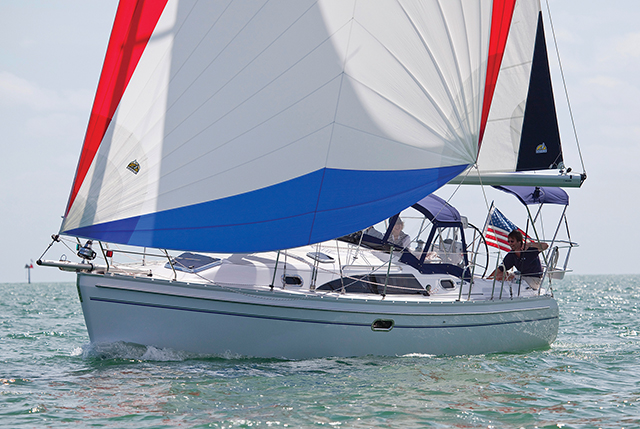15 top upgrades that transform your boat into a liveaboard voyager (published October 2012)
Whether you are buying a new boat through a dealer or a used boat through a broker, you will have abundant help deciding just which model is right for you and your cruising plans. But once the boat is yours, you will have to make a lot of decisions on how to best equip or fit her out for your intended purposes and budget.
BWS has been through the fitting out process several times over the years, and here is our selection of the top 15 upgrades that will make life aboard safer, more comfortable and more fun.
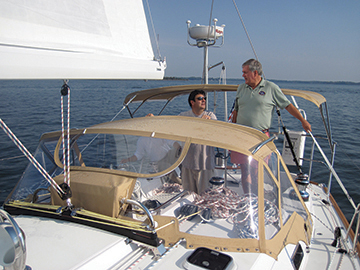 Canvas. Protecting yourself from the sun and rain while in the cockpit is essential to the well-being of the crew. Most cruisers add a strongly built dodger with large glassine windows that open via zippers, a bimini top over the helms, and an insert that fits between the dodger and the bimini that can be removed in good weather. If you are going to sea, you may want to add weather cloths on both sides of the cockpit and lee cloths for the sea berths below.
Canvas. Protecting yourself from the sun and rain while in the cockpit is essential to the well-being of the crew. Most cruisers add a strongly built dodger with large glassine windows that open via zippers, a bimini top over the helms, and an insert that fits between the dodger and the bimini that can be removed in good weather. If you are going to sea, you may want to add weather cloths on both sides of the cockpit and lee cloths for the sea berths below.
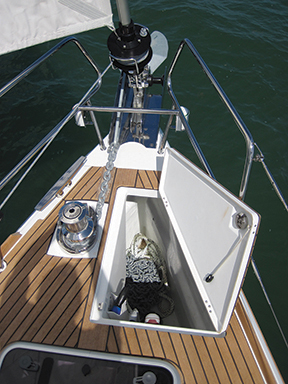 Anchor system. Staying hooked to the bottom is fundamental to safe and happy cruising unless you never leave the marina. We call it a “system” because you need to combine tools and techniques to anchor reliably in all conditions. On most cruising boats, an all-chain rode should be the primary rode backed up by a heavy nylon rode with at least 10 feet of chain. A heavy windlass is the tool you need to handle a chain rode. For anchors, you need hooking anchors for most conditions, fluke anchors for mud and soft sand, and a fisherman-style anchor if you will be anchoring in rocky, kelpy or heavy grass bottoms.
Anchor system. Staying hooked to the bottom is fundamental to safe and happy cruising unless you never leave the marina. We call it a “system” because you need to combine tools and techniques to anchor reliably in all conditions. On most cruising boats, an all-chain rode should be the primary rode backed up by a heavy nylon rode with at least 10 feet of chain. A heavy windlass is the tool you need to handle a chain rode. For anchors, you need hooking anchors for most conditions, fluke anchors for mud and soft sand, and a fisherman-style anchor if you will be anchoring in rocky, kelpy or heavy grass bottoms.
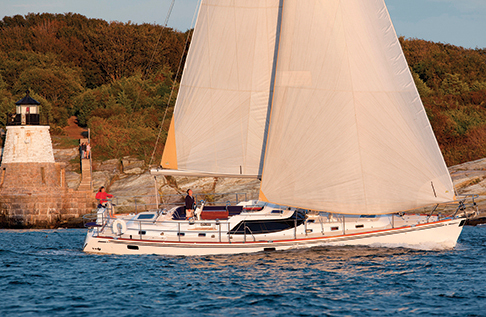 Quality sails. The boat will come with sails, but in many cases you will want to replace old ones or upgrade the sails that come standard on a new boat. You want durability, good shape and enough power to drive the boat in all conditions. High-quality Dacron is most often used by cruisers, but more and more laminated sails are finding their way onto offshore boats. The better sailor you are, the more you will require in your sails. Don’t forget to carry downwind sails such as a gennaker or reacher, or multipurpose spinnaker.
Quality sails. The boat will come with sails, but in many cases you will want to replace old ones or upgrade the sails that come standard on a new boat. You want durability, good shape and enough power to drive the boat in all conditions. High-quality Dacron is most often used by cruisers, but more and more laminated sails are finding their way onto offshore boats. The better sailor you are, the more you will require in your sails. Don’t forget to carry downwind sails such as a gennaker or reacher, or multipurpose spinnaker.
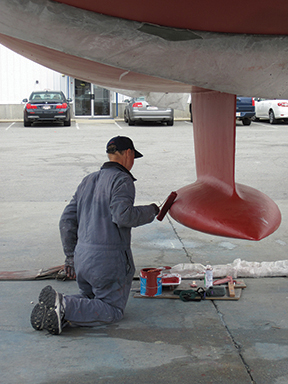 Fair bottom. Nothing slows you down and makes a passage drag out more than an unfair or foul bottom. Take the time to fair the bottom, keel and rudder by grinding down old paint and filling and fairing irregularities. Then, coat the bottom with a hard epoxy barrier coat and at least two coats of high quality antifouling paint. Don’t skimp on antifouling; you really do get what you pay for here and it is entirely worth it.
Fair bottom. Nothing slows you down and makes a passage drag out more than an unfair or foul bottom. Take the time to fair the bottom, keel and rudder by grinding down old paint and filling and fairing irregularities. Then, coat the bottom with a hard epoxy barrier coat and at least two coats of high quality antifouling paint. Don’t skimp on antifouling; you really do get what you pay for here and it is entirely worth it.
Folding/feathering propeller. Sailing with a fixed three-blade propeller is like dragging a big bucket behind the boat—it will cost you up to a knot of boat speed. Upgrading to a feathering or folding propeller will give you that knot back and will add 25 miles or so to daily runs when on passage. There are several top brands, so you will want to see which types of props work well on boats like yours.
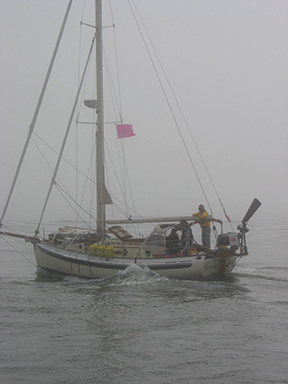 Autopilot & self-steering. Most cruisers sail with only two or three people aboard, so they are very reliant on durable and accurate mechanical steering systems that can manage the helming for days on end. A robust autopilot that can handle your boat in a wide range of conditions is the item to start with. Then you can either add a backup autopilot or opt to mount a mechanical windvane on the stern, which will steer your boat for weeks without consuming an amp from the battery bank.
Autopilot & self-steering. Most cruisers sail with only two or three people aboard, so they are very reliant on durable and accurate mechanical steering systems that can manage the helming for days on end. A robust autopilot that can handle your boat in a wide range of conditions is the item to start with. Then you can either add a backup autopilot or opt to mount a mechanical windvane on the stern, which will steer your boat for weeks without consuming an amp from the battery bank.
 Safety gear. This is a broad and important topic. For the boat, you can add jacklines on deck, a throwing line in the cockpit, a liferaft, extra flares, a Lifesling and of course an EPIRB. Each crewmember should have an inflatable life jacket-harness with a tether, a personal strobe light and whistle, and, if possible, a personal locator beacon. Safety at sea is as much about seamanship and attitude as it is gear, so a vital element of being safe is to embrace the Three Ps—planning, preparation and practice.
Safety gear. This is a broad and important topic. For the boat, you can add jacklines on deck, a throwing line in the cockpit, a liferaft, extra flares, a Lifesling and of course an EPIRB. Each crewmember should have an inflatable life jacket-harness with a tether, a personal strobe light and whistle, and, if possible, a personal locator beacon. Safety at sea is as much about seamanship and attitude as it is gear, so a vital element of being safe is to embrace the Three Ps—planning, preparation and practice.
The right clothing. If you are cold and wet or hot and exhausted, you are setting yourself up to make bad decisions that can lead to disasters. Each crew needs to have proper boat shoes and sea boots, bibs or salopettes, and a sturdy waterproof jacket. You don’t need the heaviest foul weather gear, but good quality is vital. For cold conditions, synthetic or Merino wool layering tops and bottoms work well and dry quickly. In hot climates, brimmed hats, lightweight long sleeve tops and shorts that dry quickly help keep you comfortable. Cotton is not your friend at sea.
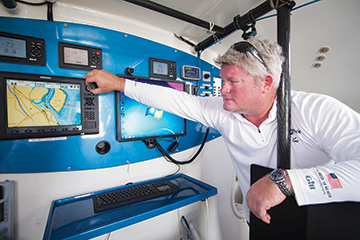 Sailing instruments. Speed, depth and wind instruments are the basics of any cruising electronics package. Speed and wind will help you sail your boat better, and that is always more fun. Speed also allows you to keep a dead reckoning of where you are in the absence of other electronics. Depth is a vital navigational tool for any and all encounters with the coastline, whether it be navigating along depth contour lines or selecting the right spot to anchor for the night.
Sailing instruments. Speed, depth and wind instruments are the basics of any cruising electronics package. Speed and wind will help you sail your boat better, and that is always more fun. Speed also allows you to keep a dead reckoning of where you are in the absence of other electronics. Depth is a vital navigational tool for any and all encounters with the coastline, whether it be navigating along depth contour lines or selecting the right spot to anchor for the night.
GPS & chartplotter. GPS has changed the way we sail since it makes navigation so easy and accurate; we wouldn’t go to sea without it and a handheld backup. Add a chartplotter and digital charts and you have a truly powerful navigation system that helps make sailing safer and passages shorter. Dedicated chartplotters are the way most cruisers choose to navigate, but many also have laptop or tablet navigation systems as backup for the chartplotter or as their main navigational electronics; you can add an inexpensive GPS to your laptop and download charts from the Internet. For advanced routing software, a PC is the way to go. Plus, a PC enables you to use email and download weather via a sat phone or through your single sideband radio.
Radar & AIS. Many veteran navigators consider radar the most useful piece of electronics aboard because it deals with the real world around you and allows you to track shipping near you and see buoys and landmarks when visibility is nil. Add an automated identification system that broadcasts your position and information and receives the same from any boats or ships nearby, and you have two really powerful early warning and navigation systems that have saved many lives.
Communications. Many of us enjoy the blessed silence of the sea, but we also like to be able to communicate with vessels and shore stations around us and stay in touch with the folks at home. A high quality VHF radio with a RAM mic in the cockpit is essential. If you are heading offshore or far from home, an SSB radio is a very useful tool that can be used for voice comms, and via a modem can link you to email and weather sources. A sat phone will be more reliable than SSB and can be used for voice and data anywhere you have reception; more and more cruisers are opting to stay connected via satellites. Also, a cell phone that can accept SIM cards from foreign countries will make telephone communication accessible when sailing abroad.
 Battery bank & inverter. If we add all of the electronics discussed thus far, we will increase our demand for electricity by a huge factor. Modern cruisers can easily require 150 to 200 amp hours of electricity daily. You should have at least double that in your house battery bank, which means you may have to add two or even three batteries to the standard house bank on your new boat. Buy all of the batteries at the same time and from the same brand and go with quality. By adding a high output inverter, you will be able to run power tools, charge batteries and even use a microwave oven.
Battery bank & inverter. If we add all of the electronics discussed thus far, we will increase our demand for electricity by a huge factor. Modern cruisers can easily require 150 to 200 amp hours of electricity daily. You should have at least double that in your house battery bank, which means you may have to add two or even three batteries to the standard house bank on your new boat. Buy all of the batteries at the same time and from the same brand and go with quality. By adding a high output inverter, you will be able to run power tools, charge batteries and even use a microwave oven.
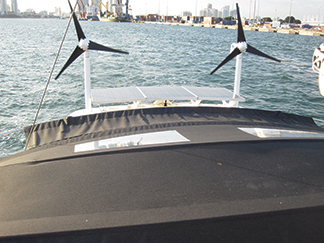 Energy systems. With all of those amps needing to be replaced, you will need to create a charging system that can keep up with the demand. A high output alternator on your main engine that charges via a smart regulator is a good place to start. You can then add solar panels and wind generators to provide a constant source of passive energy generation that will give you a high degree of energy independence.
Energy systems. With all of those amps needing to be replaced, you will need to create a charging system that can keep up with the demand. A high output alternator on your main engine that charges via a smart regulator is a good place to start. You can then add solar panels and wind generators to provide a constant source of passive energy generation that will give you a high degree of energy independence.
Refer & freezer. Most boats come with a basic refrigeration system and a poorly insulated fridge box that will suck a lot of amps to function and will not stay really cool or keep food frozen in warm climates. There are several ways to improve this and have a functioning freezer. You can divide a fridge box in half and add a second compressor to transform one half into a freezer while the other half remains the fridge. Or, you can build a separate box under a settee or elsewhere, with massive insulation, and use that as your freezer—again with a second compressor. Or you can buy a standalone 12v portable freezer and tuck it away in a locker somewhere accessible—the simplest and easiest solution.

















